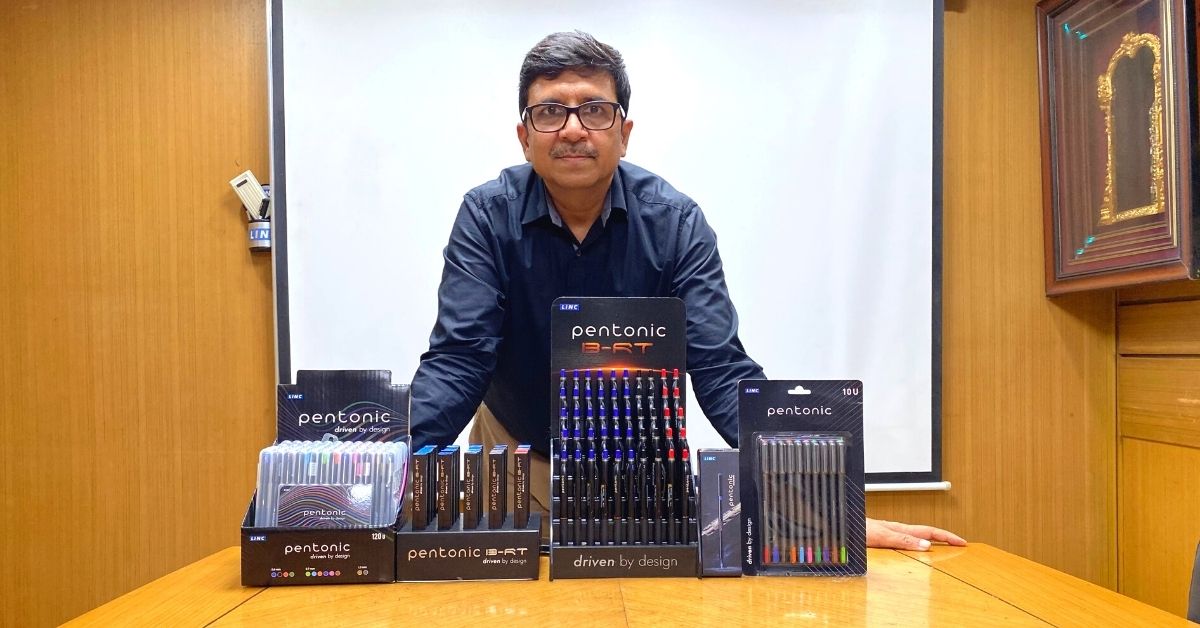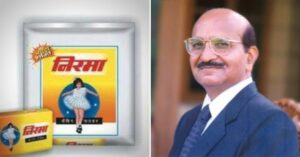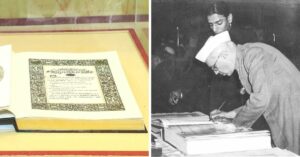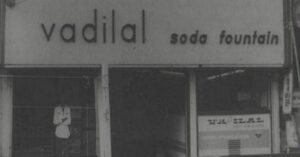How One Student’s Search For Affordable Pens Gave India Its Cheapest Gel Pen At Rs 5
Linc Pen & Plastics Ltd was launched in the 70s to provide an affordable alternative to overpriced gel pens for Indian students. Deepak Jalan, managing director and son of founder Suraj Mal Jalan, talks about how the company has established itself in both rural as well as urban India

Pune-based Amruta Patil recalls how her pre-examination ritual involved her making a trip to the stationery shop to buy a pencil, eraser, a black ball pen and a set of five gel pens. These gel pens would help her get through her entire semester examination for attempting the seven subjects in her Business Administration degree. She says she diligently followed this ritual through all three years of her graduation.
“The gel pen had a good grip, enabled smooth writing, lasted long enough for the examination, and was pocket-friendly. The brand never changed, as it was the cheapest gel pen available compared to others in the market. I felt less guilty if I lost one,” Amruta, who graduated college in 2010, says.
This pen was the Linc Ocean gel pen.
Like for Amrita, this pen is the preferred choice for many students across India, due to its high-quality ink and minimal pricing — one pen costs only Rs 5. Nearly five million Ocean gel pens are sold across India every month, making it one of the best selling pens in the company’s history.
The right pen to script success with

Linc helped disrupt the gel pen market and reach both urban and rural pockets of the country. “The pen was launched in 2003, and continues to be sold at the same price. The reason it could penetrate the market deeply was the cost factor,” says Deepak Jalan, managing director of Linc Pen & Plastics Ltd.
With over 50 varieties of pens, the Kolkata-based company, which started in 1976, clocks an annual turnover of about Rs 400 crore.
Speaking with The Better India, Deepak says, “It was not the first gel pen in the Indian market. But earlier entrants and their competitors were selling their products at a price that was five times higher. The companies that dominated the gel pen market offered them at Rs 20-25. This was unaffordable for many students, and mothers found it difficult to pay a high cost for a product whose refill lasted shorter than the ball pen.”
The gel pen market was growing because of its unique qualities, Deepak says.
“The gel pen was launched around 1996-97 in the country. It had an edge over fountain and ballpoint pens. In India, students have always shifted from using pencils to pens when they progress to secondary classes. Even back then, using fountain pens was messy and inconvenient, because they would often leak and were made of poor quality. However, these pens used water-based ink, which provides more control while writing. Meanwhile, ballpoint pens were not preferred by mothers because they affected the handwriting. However, they had good tips. So gel pens offer the best of both worlds, because their tip is like that of a ballpoint pen, and the refill contains water-based ink.”
Hence, the company decided to offer an affordable gel pen. “Like other companies in the field, we used Japanese ink, but built a good quality tip and engineered a low-cost solution for the body. The move helped bring the costs down, whilst maintaining the writing quality,” Deepak says.
Deepak says that mothers and students usually bought the pens in sets of five or ten. “By buying these pens in sets, the overall costs were reduced to 50%. Hence, it became the much-preferred pen in urban and rural areas,” he says.
Interestingly, the company had launched its first gel pen called Hi-School gel pen in 2001 and priced it at Rs 10. “It became an instant hit. It was still the cheapest in the market. But the Ocean gel pen overtook the sales of its predecessor,” Deepak chuckles.
‘King Khan’s choice of pen’

Deepak says that innovating the product and making high-quality pens has been the forte of the company, which was started by his father Suraj Mal Jalan.
“My father launched the company in 1976. He moved from Rajasthan to Kolkata in the 1960s to pursue higher studies. He faced the difficulty of non-affordability while buying good quality pens during his academic life,” he explains.
Deepak says that using fountain pens in those days was a messy affair as the ink would spill and required regular maintenance. “Then came the ballpoint pens, which cost Rs 10, which was expensive for students at the time,” he adds.
Deepak says back then, the R&D in the pen manufacturing industry in India was poor. “My father took help from two friends from the industry and invested a few thousand rupees, and imported the ink from Germany, and the tip from Switzerland. He set up the company to manufacture ball pens at Rs 2,” he adds.
The business gradually expanded and established a stronghold in West Bengal and North East India. The company went public in 1995. In the same decade, the company also started exporting to South East Asian countries and other parts of the world including the Middle East, Africa and USA.
But Deepak says that entering the gel pen market helped widen its market beyond Eastern India. “The two back-to-back gel pen launches helped reach Tier I, II and III cities. The pen manufacturing industry is very fragile and vulnerable. Hence, it was a big achievement,” he adds.
He explains that pens usually look similar and have almost the same built quality. “The brand does not matter to the customers unless the pen stands out, which is rare. Products such as Reynolds 045 has been able to achieve that for decades now,” Deepak says.
He adds that each company launches multiple pens each year. “We release about three products each year. It is to create novelty in the market and offer varieties for the young generation who prefer trying new items. Thus, the competition becomes tough,” Deepak says.
The company also roped in Bollywood celebrity Shah Rukh Khan in 2008 to endorse the gel pens. “It helped the product earn a distinct identity and become popular. Since then, it has established itself among generations of school students, and has been their preferred choice,” he says.
Apart from the two gel pens, Pentonic, Glycer and Glitter are other varieties that earn a majority of the revenue for the company. The cost of the pens ranges between Rs 5 and 20.
In 2012, Japan’s Mitsubishi Pencil picked up a 13% stake in Linc.
How Covid changed the game

Providing insights into the changing dynamics of the industry, Deepak says many technological advancements have taken place. “The pen introduced at Rs 5 or Rs 10, ten years ago, enjoys the same pricing even today. This is because we adopted more technology in the business. For example, earlier, the assembly of pens was done manually. But now the automated machines achieve the task, reducing production costs,” he adds.
Deepak says the quality of ink has also improved. “Earlier, the ink of ballpoint pens ran dry if they remained unused for a year. But now, the inks last for two years or more. The level of smoothness and quality of products has also improved,” he adds.
Besides struggling to create an identity in the market through different products, as well as improving quality, Deepak says the company was also impacted by the COVID-19 crisis. “The lockdown forced educational institutes to shut overnight. Students switched to tablets and cell phones, and they also stopped losing pens. The consumption dropped to almost 40%. The company faced a big question. How do we sell products with stationery shops closed?”
Deepak adds that the company found a solution and targeted non-stationary shops including medical stores, paan kiosks, supermarkets, and grocery stores. “Customers buy out of impulse at such places, and we successfully collaborated with 50,000 shops in India. We employed 300 people for telemarketing to coordinate with the orders and increase sales. It helped us avoid risks and ensured the safety of the sales team by having them work off field,” he says.
Deepak says plans are underway to bring sustainability into the pen manufacturing process. “The business relies on using plastic, and the ‘use and throw’ culture has aggravated pollution issues. Hence, the company introduced refillable pens. The product range, Pentonic, involving three pens, launched in 2018. This aims to promote sustainable values and culture, as well as encourage the user to buy more refills and reuse the body,” he adds.
Edited by Divya Sethu
This story made me
- 97
- 121
- 89
- 167
Tell Us More
We bring stories straight from the heart of India, to inspire millions and create a wave of impact. Our positive movement is growing bigger everyday, and we would love for you to join it.
Please contribute whatever you can, every little penny helps our team in bringing you more stories that support dreams and spread hope.



















